Students get a bird’s eye view of avian conservation
Warner Park Nature Center takes biology students under its wing for international U.S. Fish & Wildlife tagging project.
Keely Hagan and Janel Shoun-Smith | 615-966-7078 |
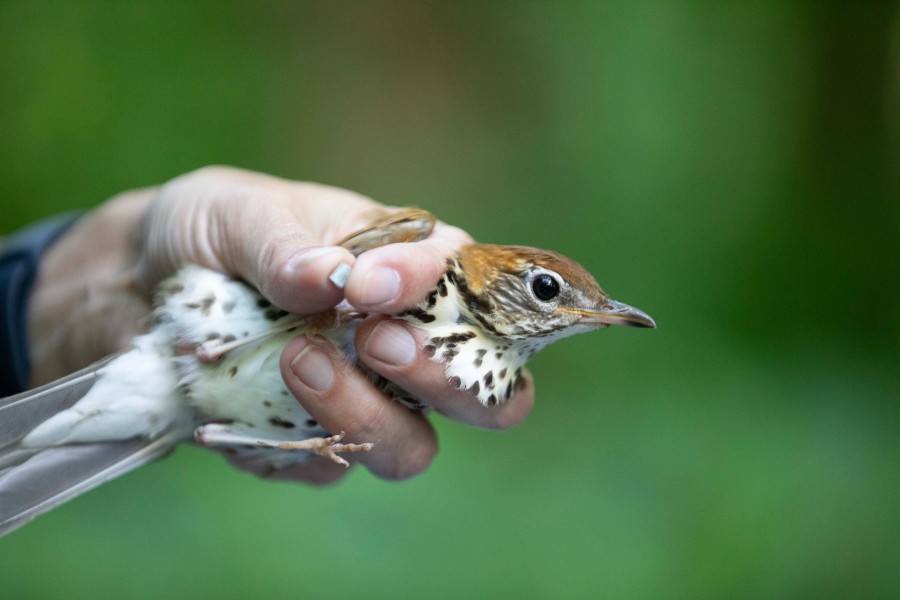
This summer, biology students are helping to place Motus tracking devices, the metal band seen between the fingers, on wood thrushes to track their migration throughout North America.
This story was updated on June 13, 2024.
This summer at Nashville's Warner Parks, visitors may spy more than bluebirds or purple martins. They may catch a glimpse of Lipscomb student interns conducting cutting-edge research for the U.S. Fish & Wildlife Service.
Lipscomb biology students have served as interns at the parks for nine summers, but this year brought a special opportunity to be part of an international conservation project for the wood thrush.
Working with Laura Cook, bird research coordinator at Warner Park Nature Center, Lipscomb junior biology majors and student interns, Amelia Browning and Alexandra “Lexi” Price, are contributing valuable data to the study of the bird’s migration patterns throughout the hemisphere. The initiative currently involves bird-conservation partners in 19 U.S. states and Canada, Mexico, Belize, Guatemala, Honduras, Nicaragua and Costa Rica.
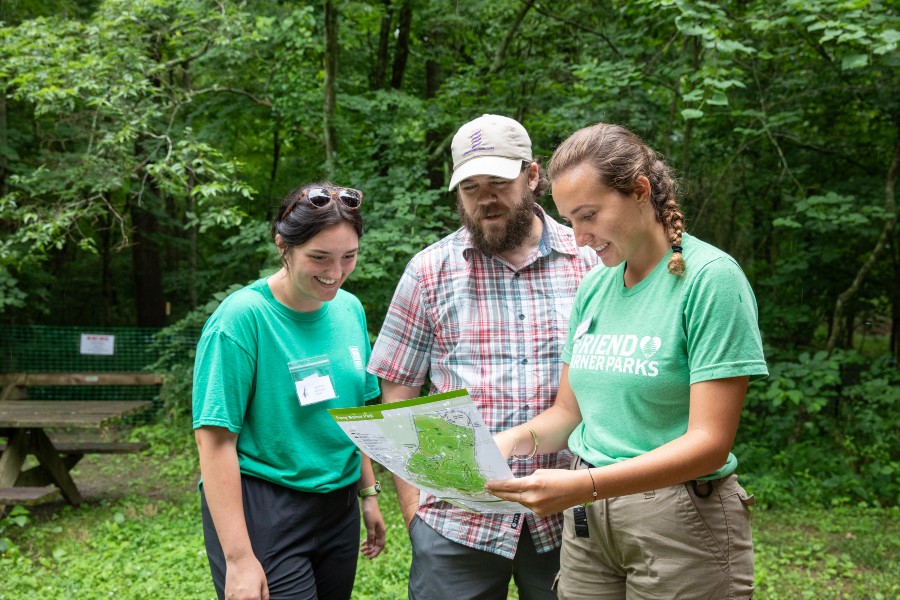
John Lewis (A ’00), biology professor, has supervised Lipscomb’s Warner interns since 2016.
The goal is to deploy 600 Motus tags to better understand migratory connections, routes, timing and survival across the full life-cycle of the wood thrush to improve understanding and better plan for and address the conservation needs of the birds, a U.S. Geological Survey-designated Species of Greatest Conservation Need.
The Motus technology is one of the first such technologies light enough to use on small songbirds, said Dr. John Lewis (A ’00), biology professor, who has supervised Lipscomb’s Warner interns since 2016. Motus tags are tracked by radio towers nationwide, including 30 in Tennessee (two of which are in the Warner Parks). The goal for Tennessee is to tag 25 birds in May through July, he said.
The U.S. Fish and Wildlife project is an opportunity for Warner’s BIRD (Bird Information Research and Data) program to share its research, carried out with the help of Lipscomb interns over the past two summers, with a much larger research project.
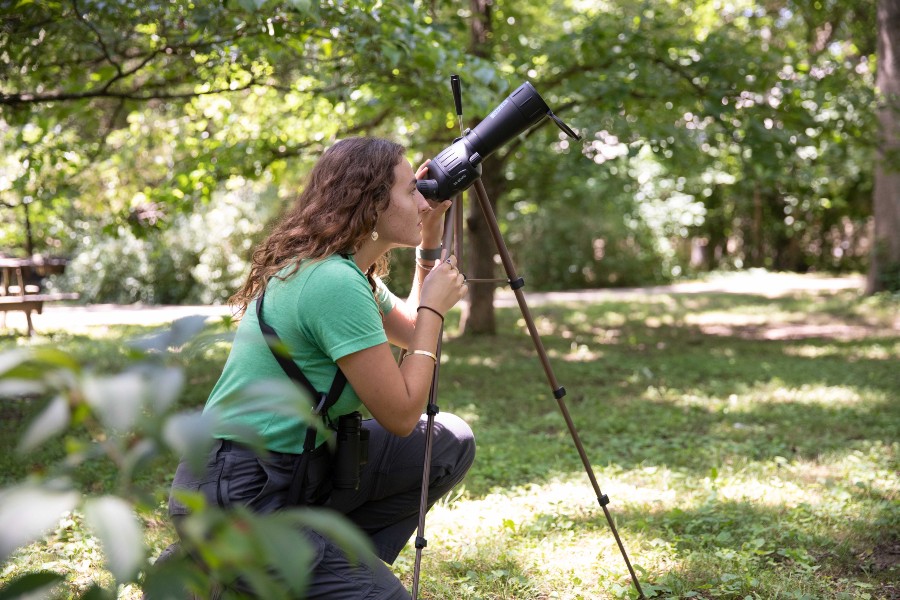
Student Intern AMELIA BROWNING MONITORING A WOOD THRUSH NEST AT WARNER PARKS in 2023.
“I am putting them in charge of finding the wood thrushes’ breeding territories located in the park within range of a Motus station,” says Cook. “They listen for the males’ songs, take time to observe their locations and document any consistency they find.
“They then assist me in playing back vocalizations that will get the wood thrush to come down into the netting so we can capture them, put on transmitters and deploy them. The interns will monitor the area with handheld receivers in order to do health checks to be sure they are healthy and to document their behavior,” she said.
Throughout the years, Lipscomb students have participated in numerous hands-on, long-term research projects focusing on avian ecology, including banding projects, radio-tagging initiatives and species-specific studies, during the nine-week summer internship program conducted in collaboration with the BIRD Program, Metro Nashville Parks and Recreation and Friends of Warner Parks.
READ MORE about student interns’ conservation research in 2023.

Laura Cook holds a wood thrush that has been tagged, showing the radio transmitter's antenna extending from the bird's body.
“Working alongside the ornithologists at the park instills a passion in our students,” said Lewis. “This type of research experience can set students apart when they are applying for a graduate program or a job. They have proven experience in taking an idea, doing the field work, writing it up and going all the way to presenting their research at a professional conference. They also gain tangible skills through their experience in putting a band or a radio tag on a bird and knowing how to use the tracking equipment.”
This is the second summer internship for Browning, who studied wood thrush nesting behavior last year. She and Price are also volunteers at the park throughout the year.
“When I started last year, I had no idea that we would do so much, like learning how to band baby birds,” said Browning. “Last summer we interacted with the state ornithologist. I never thought I’d get to do any of that as a then-sophomore in college.

In addition to studying the wood thrush, ongoing research in the Warner Parks includes tracking a colony of about 30 barn swallows that nest in the Steeplechase stalls.
“I think this summer will be really valuable because not many people have the opportunity to work on a project with this many people. We have been able to hear other people’s techniques and share experiences, which could be helpful for future research endeavors,” said Browning.
Before her Warner internship, Browning said she “thought research meant a lot of lab work and I just wanted to be outside. Once I started the internship, I realized how great hands-on research could be, and so now I would love to go into ornithology research,” she said.
This summer, the interns helped to lead a workshop for the wood thrush project for several researchers from around the state. “It has been so much fun to meet other researchers from different parts of Tennessee and make connections. I have really enjoyed having an entire team working to find wood thrush nests instead of doing it by myself like last year,” said Browning.
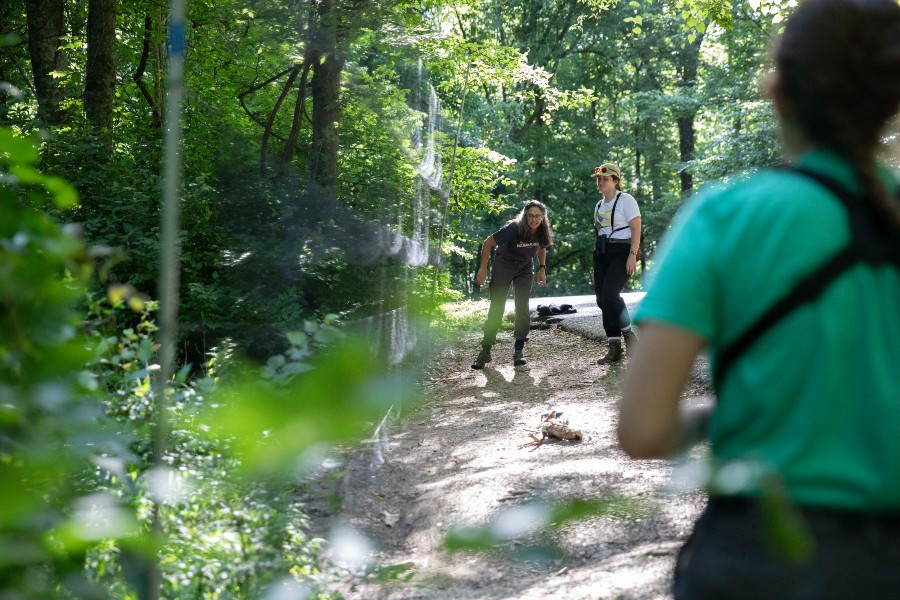
The interns play back vocalizations and set out a stuffed wood thrush to attract the birds to come down into the netting so researchers can take measurements and put transmitters on their backs with a leg-loop harness..
Before her Warner internship, Browning “thought research meant a lot of lab work and I just wanted to be outside. Once I started the internship, I realized how great hands-on research could be, and so now I would love to go into ornithology research,” she said.
Summer interns select their own research question to study and see it through from data collection to presentation at a professional meeting, said Lewis. “Not many undergraduates are afforded that opportunity and it is a very real way our students have benefitted from this partnership with Warner Parks,” he said.
Every year, interns present their research projects at the university’s Student Scholars Symposium, and most also present at regional and national conferences, said Lewis. Senior Anna Money, a Warner intern in 2022 and 2023, presented her research at the Purple Martin Conservation Association’s Purple Martin Conference in 2022. Last fall, 2023 interns Browning and Anna Sawyer (BS ’24) made poster presentations at the national conference of the Inland Bird Banding Association, which was held at Warner Parks that year.
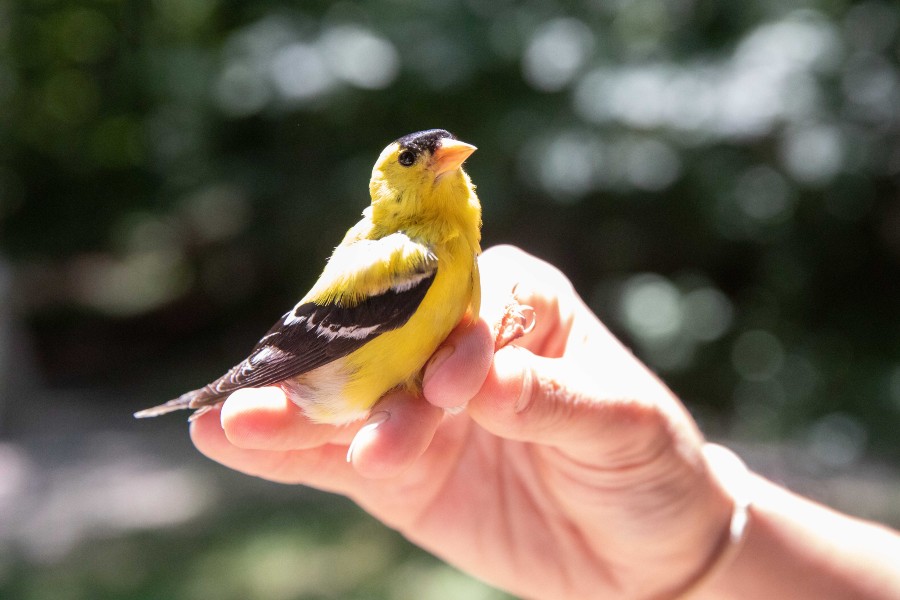
Students study species found in Warner Parks including purple martins, ruby-throated hummingbirds, Eastern Bluebirds and this American Goldfinch.
“It was the first time I had done my own research and the first time I had presented my own research,” said Browning.
Browning is continuing her research study on how the nesting and breeding behavior of wood thrushes is impacted by human activity during her internship this summer as well as expanding the study to Timberland Park on the Natchez Trace Parkway in Franklin, Tennessee, as well. “It’s less trafficked so I want to compare the two for the thrush’s nesting behavior,” she said. “Typically their nests are around our eye level but in areas with a lot of human activity, the nests are much higher.”
In addition to studying the wood thrush, ongoing research of Lipscomb students in the Warner Parks includes tracking a colony of about 30 barn swallows that nest in the Steeplechase stalls. Students also study other species including purple martins, ruby-throated hummingbirds and Eastern Bluebirds.

As part of the U.S. Fish & Wildlife project they take various measurements, such as noting feather replacement which indicates the age of the bird.
The park’s research and Motus towers have opened doors connecting Warner and Lipscomb with other groups working on tracking and conservation, including a special project two years ago when purple martins had roosted in the trees at the Schermerhorn Symphony Center in downtown Nashville. During that time, Lipscomb students were able to track a purple martin that had been caught and banded at Warner Parks then became part of the huge roost in downtown Nashville and migrated all the way to Costa Rica, said Lewis.
“This is a fabulous partnership,” said Cook. “In one sense, the interns are extra hands, helping us out with summer bird banding and monitoring the barn swallow nests, in addition to their individual research. But the bigger part to me is watching them learn how to observe the world differently, understand it differently and opening up their senses to nature that’s all around them.”
Partners like Warner Parks help amplify the power of discovery. To learn more about how to partner with the Department of Biology, in the College of Liberal Arts & Sciences, on conservation projects and more, contact john.lewsi [at] lipscomb.edu (subject: Interested%20in%20Partnering%20in%20Research) (John Lewis).